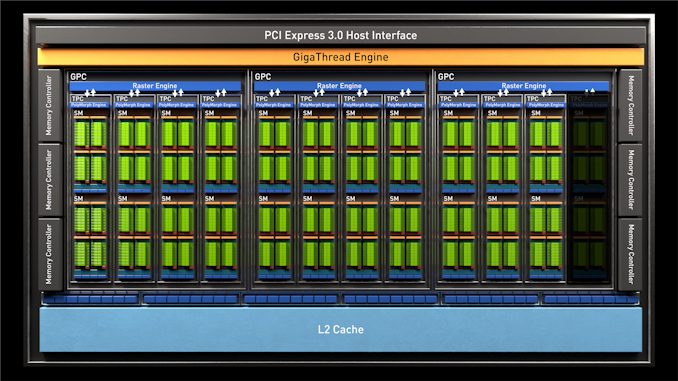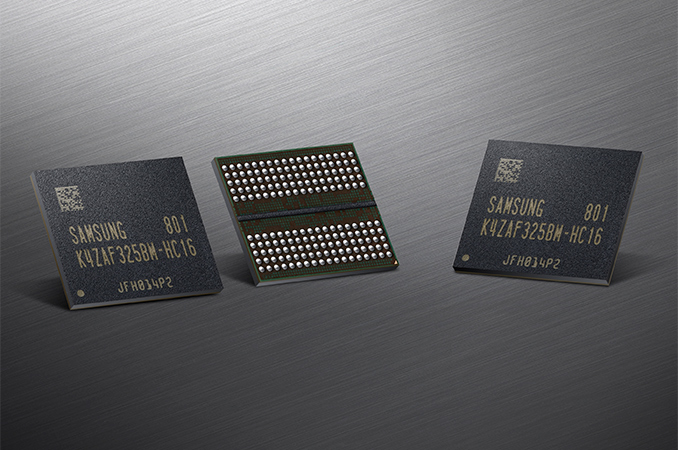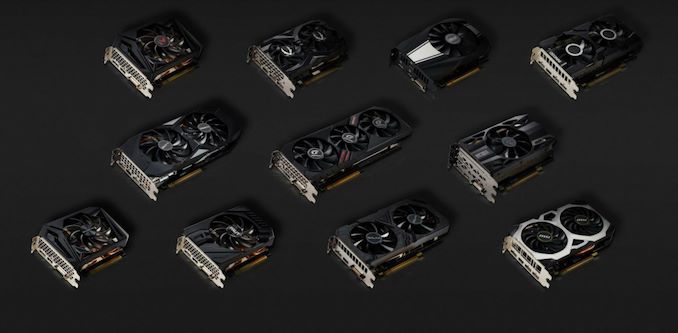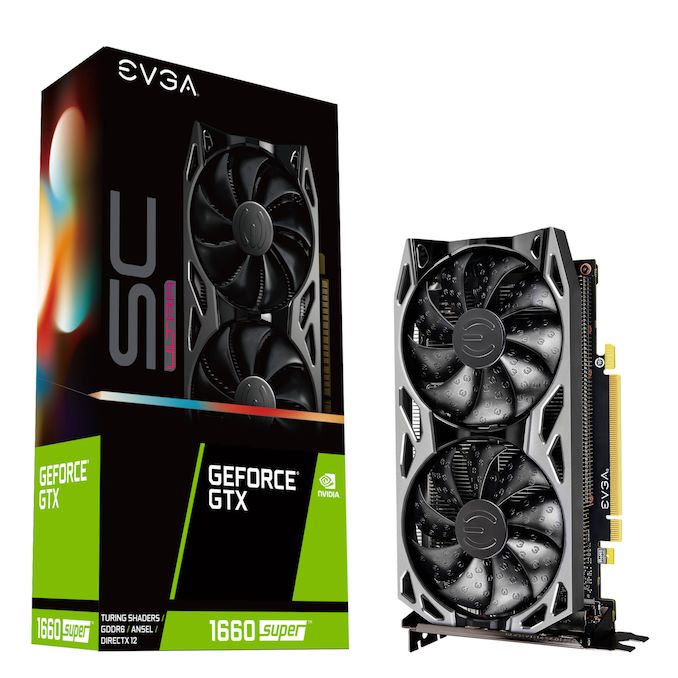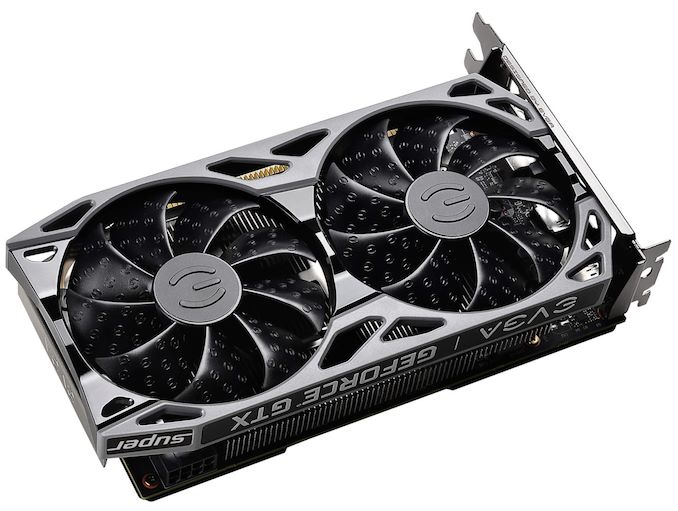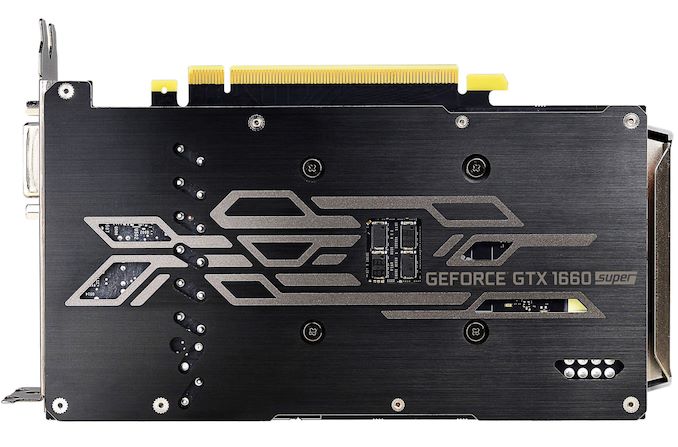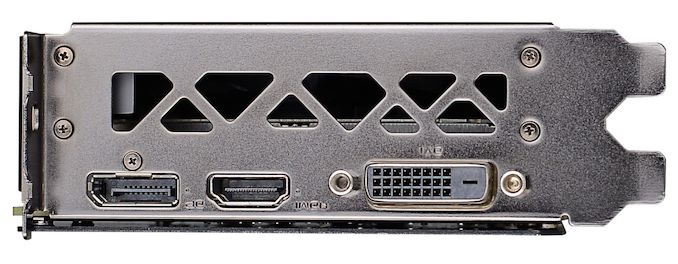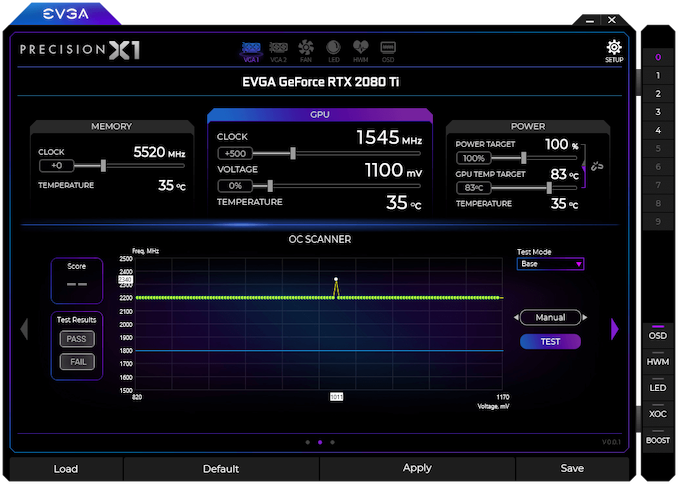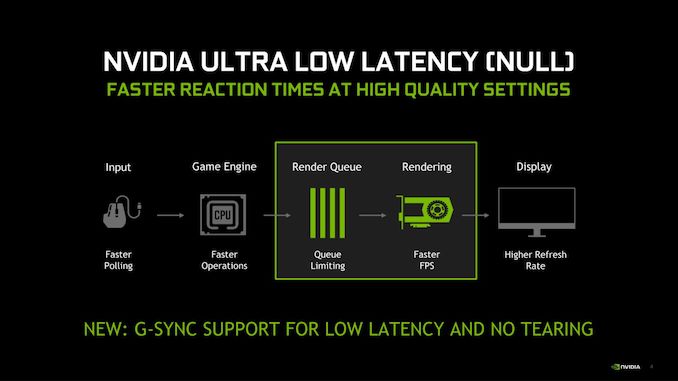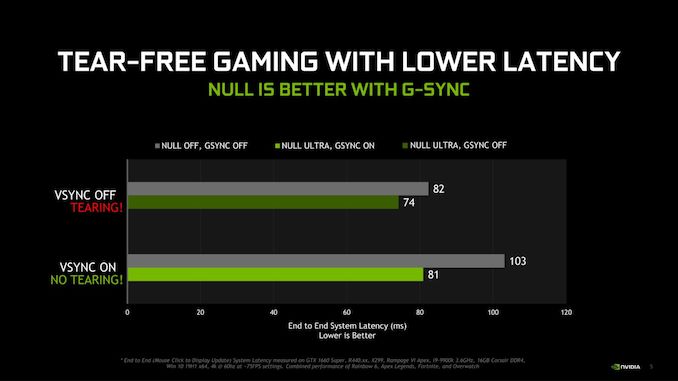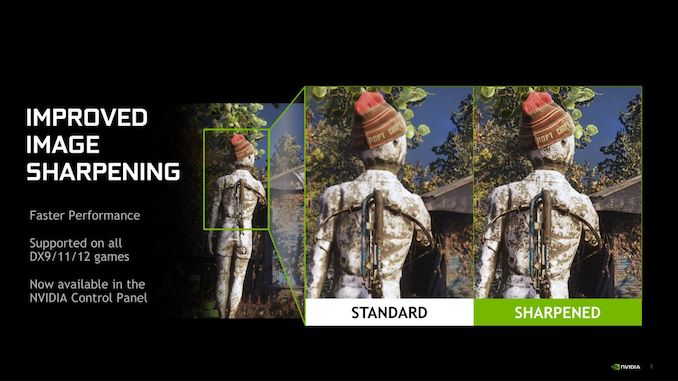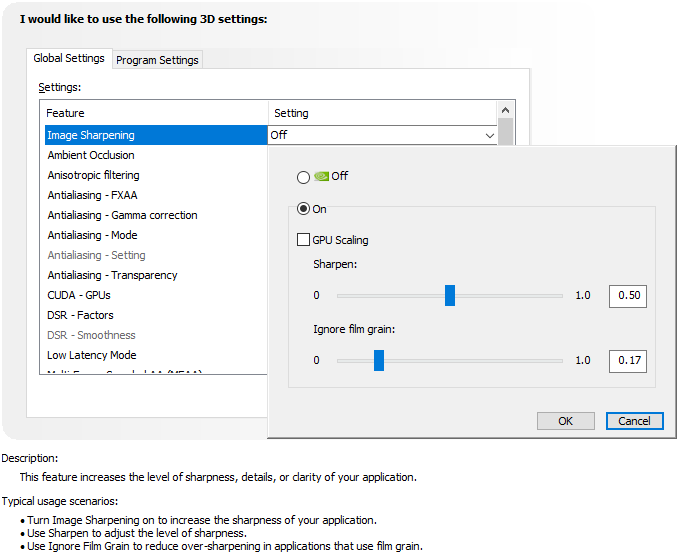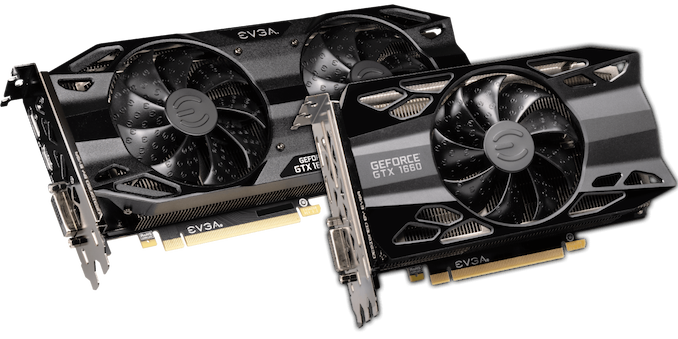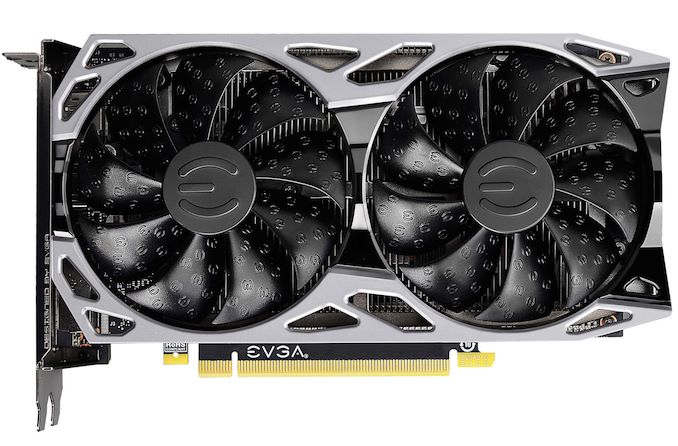
Original Link: https://www.anandtech.com/show/15010/the-nvidia-geforce-gtx-1660-super-review-feat-evga
The NVIDIA GeForce GTX 1660 Super Review, Feat. EVGA SC Ultra: Recalibrating The Mainstream Market
by Ryan Smith on October 29, 2019 9:00 AM EST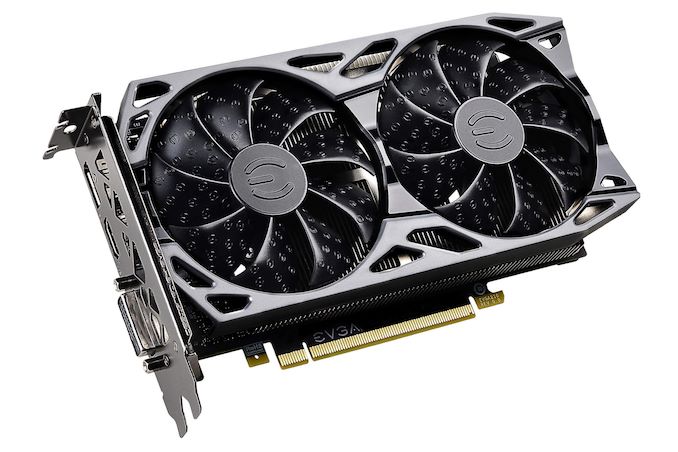
After taking a break following the launch of NVIDIA’s GeForce RTX 20 series Super cards, as well as AMD’s new RDNA architecture-based Radeon RX 5000 series cards, the video card market is heating back up again just in time for the all-important holiday shopping season. Looking to fill in the mainstream portion of the market, AMD is already shipping its Radeon RX 5500 series cards to OEMs – with retail to follow shortly – and meanwhile NVIDIA is making its own machinations for the market.
Kicking off the first of the actual hardware launches for this holiday rumble is NVIDIA, who is announcing their GeForce GTX 1660 Super. This is a relatively minor, but none the less interesting revision to the GTX 1660 family that adds a 1660 (vanilla) SKU with faster GDDR6 memory for improved performance. Along with the GeForce GTX 1650 Super (shipping in late November), these two cards are going to be the backbone of NVIDIA’s mainstream efforts to close out the year. And while NVIDIA’s other GTX 1660 cards aren’t going anywhere, as we’re going to see today, with its $229 price tag, the GDDR6-equipped GTX 1660 Super is pretty much going to make the other 1660 cards redundant.
The fourth Super card to be launched by NVIDIA, the GTX 1660 Super is a bit of a harder read than the high-end cards that launched this past summer. In terms of performance, the card is just shy of the GTX 1660 Ti, and priced just north of the GTX 1660 (vanilla). But unlike the other Super cards, this launch isn’t the same kind of transparent price shuffle that the earlier launch was; NVIDIA isn’t discontinuing any cards this time, and the retail shelves will be shared by all three GTX 1660 series cards for the months to come. None the less, this latest card does at least fill the same basic role of serving as a kind of mid-generation kicker – even if the original GTX 1660 only launched 7 months ago.
| NVIDIA GeForce GTX 1660 Series | |||||
| Card | Configuration | Price (10/29) | |||
| GTX 1660 Ti | Full TU116 w/12Gbps GDDR6 |
$279 | |||
| GTX 1660 Super (New) | Cut-down TU116 w/14Gbps GDDR6 |
$229 | |||
| GTX 1660 | Cut-down TU116 w/8Gbps GDDR5 |
$219 | |||
The wildcard factor here, as is often the case, is AMD. The company has already announced some of its RX 5500 product family. However it’s not clear just what to expect from the cards in terms of performance, especially as AMD has been framing it relative to NVIDIA’s lower-end GTX 1650. So while at face value, the GTX 1660 Super seems like an NVIDIA counter to AMD’s impending launch, outside of the AMD and NVIDIA testing labs, it’s remains to be seen where things end up.
The one thing that is clear, however, is that this may as well be a de facto price cut for NVIDIA’s GeForce GTX 1660 Ti. Set to be released at $50 less than NVIDIA’s fastest GTX 1660 card, the GTX 1660 Super is only the slightest bit slower than the GTX 1660 Ti, delivering around 96% of its performance – barely outside of our regular run-to-run variation. When NVIDIA went about cutting down the GTX 1660 Ti to create the original GTX 1660, the single biggest change there was swapping out GDDR6 for cheaper GDDR5. Now that they’ve effectively undone this – and then some – most of the performance that NVIDIA shaved off for the GTX 1660 has come back in the lower-priced Super card. As a result, while the GTX 1660 Super doesn’t offer anything in terms of performance that we haven’t seen before, it brings this level of Turing performance down to a lower price, and, NVIDIA hopes, something that’s more enticing to GTX 10 and 9-series owners who have been put-off by the relatively high prices of recent cards.
| NVIDIA GeForce Specification Comparison | ||||||
| GTX 1660 Ti | GTX 1660 Super | GTX 1660 | GTX 1060 6GB | |||
| CUDA Cores | 1536 | 1408 | 1408 | 1280 | ||
| ROPs | 48 | 48 | 48 | 48 | ||
| Core Clock | 1500MHz | 1530MHz | 1530MHz | 1506MHz | ||
| Boost Clock | 1770MHz | 1785MHz | 1785MHz | 1708MHz | ||
| Memory Clock | 12Gbps GDDR6 | 14Gbps GDDR6 | 8Gbps GDDR5 | 8Gbps GDDR5(X) | ||
| Memory Bus Width | 192-bit | 192-bit | 192-bit | 192-bit | ||
| VRAM | 6GB | 6GB | 6GB | 6GB | ||
| Single Precision Perf. | 5.5 TFLOPS | 5 TFLOPS | 5 TFLOPS | 4.4 TFLOPs | ||
| TGP | 120W | 125W | 120W | 120W | ||
| GPU | TU116 (284 mm2) |
TU116 (284 mm2) |
TU116 (284 mm2) |
GP106 (200 mm2) |
||
| Transistor Count | 6.6B | 6.6B | 6.6B | 4.4B | ||
| Architecture | Turing | Turing | Turing | Pascal | ||
| Manufacturing Process | TSMC 12nm "FFN" | TSMC 12nm "FFN" | TSMC 12nm "FFN" | TSMC 16nm | ||
| Launch Date | 02/22/2019 | 10/29/2019 | 03/14/2019 | 07/19/2016 | ||
| Launch Price | $279 | $229 | $219 | MSRP: $249 FE: $299 |
||
So what exactly is the GeForce GTX 1660 Super? In short, take a GTX 1660 (vanilla), replace the 8Gbps GDDR5 with 14Gbps GDDR6, dial up the TDP a few watts to accommodate the increased power needs, and you have a GTX 1660 Super.
On the GPU front, nothing has changed relative to the GTX 1660. It’s the same TU116 GPU in the same partially-disabled configuration with the same clockspeeds. Truthfully, I’m not even sure NVIDIA’s GPU binning operations changed for this product, or if they just had partners slap TU116-300 GPUs on a PCB wired for GDDR6. Either way, the net result is that on-paper performance hasn’t changed from GTX 1660, as the GPU itself can process just as many pixels, texels, and data elements as before.
Instead, what has changed is the memory support, and this is where the vast majority of GTX 1660 Super’s performance gains lie. Whereas the original GTX 1660 shipped with 8Gbps GDDR5 as both a means to cut costs and differentiate/segment the card from the full-fledged GTX 1660 Ti, GTX 1660 Super gets all the memory bandwidth it can handle. NVIDIA has given it 6GB of 14Gbps GDDR6, the fastest grade of memory they currently have available. This gives the GTX 1660 Super 336GB/sec of memory bandwidth, 75% more bandwidth than the original GTX 1660, or as much as the RTX 2060. And this extensive amount of bandwidth is almost entirely responsible for the 12% performance gains we see over the original card.
In fact, the GTX 1660 Super actually has more memory bandwidth than the higher-end GTX 1660 Ti. That card shipped with slightly slower (and cheaper) 12Gbps GDDR6, giving the GTX 1660 Super a bandwidth advantage that further erodes the small lead that the GTX 1660 Ti holds on to. As thing stand, TU116 is almost overfed by GDDR6, which is why GTX 1660 Super isn’t overtaking GTX 1660 Ti despite its advantage; at this level of performance, the extra memory bandwidth isn’t nearly as important as the extra two SMs that GTX 1660 Ti gets.
Finally, as a member of the GTX 1660, the latest card gets a very similar, but not quite identical TGP of 125W. This a small 5W increase over the GTX 1660 and 1660 Ti (as well as the GTX 1060/960 families), and appears to be mostly here to accommodate the greater power needs that come from shipping with fast GDDR6 memory – GTX 1660 Super would otherwise lose a bit of clockspeed versus the original GTX 1660. It’s also a small enough change that board vendors should have no problem accommodating the increased power needs with their existing GTX 1660 Ti designs, meaning that GTX 1660 Super cards can be readily built with current parts. The only drawback in this case is that the higher TDP and lower performance versus the GTX 1660 Ti means that GTX 1660 Super isn’t quite as power efficient as the card it otherwise renders redundant.
The Messy State of NVIDIA’s Product Stack
If it feels like NVIDIA has launched a lot of GeForce video cards over the past year, that’s because they have. In the 13 months going back to the initial launch of the Turing architecture and the GeForce RTX 20 series of cards, NVIDIA has now launched 12 different GeForce SKUs. And even if we toss out the RTX 2080 and RTX 2070, which were formally discontinued but still sit on some store shelves, NVIDIA’s current product stack is still 10 cards deep.
| NVIDIA GeForce 20/16 Series (Turing) Product Stack | ||||
| RTX 20 Series | GTX 16 Series | |||
| RTX 2080 Ti | GTX 1660 Ti | |||
| RTX 2080 Super | GTX 1660 Super | |||
| RTX 2080 (Discontinued) | GTX 1660 | |||
| RTX 2070 Super | GTX 1650 Super | |||
| RTX 2070 (Discontinued) | GTX 1650 | |||
| RTX 2060 Super | ||||
| RTX 2060 | ||||
By comparison, the GeForce GTX 10 series product stack was only 8 cards deep at its messiest point, and that was after the GTX 1070 Ti was launched some 16 months later.
To be fair to NVIDIA, some of this is because the GeForce product stack goes higher in price than before, especially with the $1100 RTX 2080 Ti. Still, NVIDIA has launched more cards at a faster pace than at any point in the past half-decade. The Super cards in particular have added significantly to this count, with NVIDIA shipping what amounts to a mid-generation refresh for their lineup not even a year into its launch. Compared to the GTX 9 series and GTX 10 series, where NVIDIA had distinct two-year product cycles and launched very little filler in between, the RTX 20 series and GTX 16 series has essentially brought us back to yearly card launches aliased over two-year GPU cycles.
Ultimately this means there are a very large number of NVIDA video card options on the market, with NVIDIA offering 5 SKUs below $300. Factor in the board vendors doing their own factory overclocks for their premium cards, and we’re looking at a GeForce for every price. As a sales strategy, market saturation is definitely a viable method to maximize sales – making sure there’s always a card at a price someone is willing to spend – but it does make something of a mess of NVIDIA’s product stack, especially now with three different GTX 1660 cards.
Product Positioning & The Competition
Shifting gears, let’s talk about the hardware behind today’s launch. As the new GTX 1660 Super cards are a mid-generation kicker of a mainstream card, there aren’t any reference cards to speak of here. Instead, this is a pure virtual launch, with all of the cards on the market being partner designs.
At this point, the partners have been shipping TU116-based cards for over 6 months, so they have been able to hone their GTX 1660 family designs. This means that they’re hitting the ground running, using their existing card designs for the GTX 1660 Super. At this point I haven’t seen any new designs specifically for the Super card, and I’m not expecting any either. So these cards will look and perform similarly to the GTX 1660 cards already on the market.
Unsurprisingly, the GTX 1660 Super occupies the same general slot within NVIDIA’s product stacks as the easier GTX 1660 cards. Which means that for system builders and upgraders alike, NVIDIA is pitching the card at the same general audience as before. That the GTX 1660 Super offers better performance for the price is definitely an improvement here, and it will presumably ensure NVIDIA gets to stay ahead of AMD’s impending cards.
Upgraders however will likely end up being a bit more discerning; Turing isn’t a whole generation ahead of the Pascal-based GTX 10 series cards with respect to performance, and the GTX 1660 Super doesn’t change this. So while it’s around 35-40% faster than a GTX 1060 6GB, GTX 1660 Super is going to be much more enticing to GTX 960 owners and the like, where the new card delivers more than twice the performance.
Meanwhile, as I mentioned towards the start of this article, while NVIDIA is launching the new GTX 1660 Super card today, they are not going to be retiring any of their other cards in its wake. So, on paper, the GTX 1660 Super is going to be positioned very narrowly between the GTX 1660 Ti and the GTX 1660 (vanilla).
At current prices, the $229 GTX 1660 Super is $50 cheaper than the GTX 1660 Ti. And with the card only trailing NVIDIA’s top 1660 card by about 4%, I would argue that the GTX 1660 Ti has been rendered redundant at this point; the GTX 1660 Ti isn’t far enough ahead to provide much in the way of value. Instead, the next real step up after the GTX 1660 Super is the GTX 2060, which is 22% faster, but running at around $100 more expensive.
Otherwise, coming from the other direction the vanilla GTX 1660 is still regularly found for around $219. With just a $10 price gap between it and the GTX 1660 Super, the Super card is the obvious choice right now, as 12% more performance is more than worth the $10. Despite all of this, NVIDIA insists that they and their partners are going to keep selling the vanilla GTX 1660. So it will be interesting to see what NVIDIA actual does here, both in terms of card supply and pricing. The GTX 1660 has to come down in price to have any future; and if that were to happen, then it might make for a decent sub-$200 spoiler.
It’s also worth noting here that NVIDIA isn’t doing any bundles or other promotional offers for any of the GTX 16 series cards, so what you see is what you get with the new cards.
Finally, the competitive situation for the GTX 1660 Super is a mixed bag. AMD is still doing what they can, and in this case is pitching the Radeon RX 590 as their closest GTX 1660 Super competitor. The admittedly awkward, late-cycle Polaris card was originally created to beat GTX 1060 6GB on performance (while throwing power efficiency out the window), which it certainly did. However this means it’s outgunned by the GTX 1660 Super by around 20% (and a whole lot less power), which is why AMD is instead using the card to stake their claim to the $199 price point. So for buyers who absolutely can’t go above $200, it’s an option; but at this point GTX 1660 Super doesn’t face any major competition.
| Q4 2019 GPU Pricing Comparison | |||||
| AMD | Price | NVIDIA | |||
| Radeon RX 5700 XT | $399 | GeForce RTX 2060 Super | |||
| Radeon RX 5700 | $329 | GeForce RTX 2060 | |||
| $279 | GeForce GTX 1660 Ti | ||||
| $229 | GeForce GTX 1660 Super | ||||
| $219 | GeForce GTX 1660 | ||||
| Radeon RX 590 | $199 | ||||
| Radeon RX 580 | $179 | ||||
| $149 | GeForce GTX 1650 | ||||
Meet The EVGA GeForce GTX 1660 Super SC Ultra
Since this latest GTX 1660 series card launch is a virtual launch like the others, NVIDIA is once again sampling partner cards to the press. For the GTX 1660 Super launch, we received EVGA’s GeForce GTX 1660 SC Ultra, a relatively straightforward dual slot, dual fan card.
| GeForce GTX 1660 Super Card Comparison | ||||
| GTX 1660 Super (Reference Specification) |
EVGA GTX 1660 Super SC Ultra | |||
| Base Clock | 1530MHz | 1530MHz | ||
| Boost Clock | 1785MHz | 1830MHz | ||
| Memory Clock | 14Gbps GDDR6 | 14Gbps GDDR6 | ||
| VRAM | 6GB | 6GB | ||
| TDP | 125W | 125W | ||
| Length | N/A | 8" | ||
| Width | N/A | 2-Slot | ||
| Cooler Type | N/A | Open Air, Dual Fan | ||
| Price | $229 | $229 | ||
The EVGA GeForce GTX 1660 SC Ultra – or for the sake of brevity in this article, the EVGA SC Ultra – is pretty typical of dual fan cards for this price range and performance class. At just under 8-inches long, the card isn’t particular massive, and is just big enough to fit a pair of 90mm fans.
EVGA typically offers both reference clock (Black) and factory overclocked versions of their GTX 1660 SC cards, and the model we’re looking at is the latter, sporting an official boost clock of 1830MHz, 45MHz higher than the reference GTX 1660 Super specifications. Notably, the card’s base clock remains unchanged at 1530MHz, but since the card is turboing all the time anyhow, it’s the boost clock tells us what we need to know. By the numbers then, EVGA’s SC Ultra has a 2.5% GPU clockspeed advantage over reference cards, so it will perform just a bit better (and further close the gap with the GTX 1660 Ti), but not significantly so with such a mild factory overclock.
Meanwhile, it’s worth pointing out that while EVGA has cranked up the GPU clockspeed a bit, it doesn’t appear they’ve deviated from NVIDIA’s reference TDP this time. So unlike their reference clocked but TDP increased XC cards that we looked at earlier this year, the SC Ultra doesn’t have any more power headroom to play with than reference cards. Thankfully for EVGA the GTX 1660 series cards haven’t been terribly TDP-constrained to begin with – we regularly beat NVIDIA’s official boost clocks – but it does mean that the card is riding on the fact that it’s clocked higher at any given voltage, which is essentially an efficiency play.
Digging down further, the SC Ultra is equipped with a fairly typical aluminum heatsink with vertical fins, and a pair of heatpipes running through it. The heatpipes are connected to the TU116 GPU via a copper (or copper-plated) baseplate, with the heatpipes and baseplate transferring heat into the heatsink proper. EVGA is also providing direct cooling for the 6 GDDR6 chips surrounding the GPU, using thermal pads to connect them to the heatsink.
Speaking of cooling, unlike their XC cards that we’ve looked at earlier this year, for their SC cards EVGA has implemented zero fan speed idle functionality, so the card’s fans will cut off when the card is idling at a low temperature. This is an increasingly common and always appreciated feature for video cards, as it allows cards to be effectively silent at idle or under light workloads.
Elsewhere, on the back of the card we find an EVGA backplate. It’s still uncommon to see backplates among non-premium midrange cards like this, so EVGA is in fairly rare company. In the case of the SC Ultra however, it’s also necessary, as the heatsink is only mounted to the PCB directly around the GPU, so the backplate is needed to keep the card and its PCB from flexing.
For power, the card relies on an 8-pin external PCIe power cable, as well as PCIe slot power. From a practical perspective this is overkill for a card that only has a 125W TDP – a 6 pin connector should work just fine here – but it’s consistent with NVIDIA’s requirements for their other GTX 1660 cards.
Finally for hardware features, for display I/O we’re looking at EVGA’s usual GTX 1660 setup of a DisplayPort, an HDMI port, and a DL-DVI-D port. While DVI ports have long been banished from high-end cards, they still sometimes show up on midrange cards so that they can be directly used with DL-DVI monitors that are still out in the world. The tradeoff, as always, is that the DVI port is taking up space that could otherwise be filed by more DisplayPorts, so you’re only going to be able to drive up to two modern monitors with the SC Ultra.
As for software, EVGA of course includes their latest EVGA Precision X1 software. Among its many features, Precision X1 allows modifying the voltage-frequency curve and scanning for auto-overclocking as part of Turing’s GPU Boost 4. Of course, NVIDIA’s restriction of actual overvolting is still in place, and for Turing there is a cap at 1.068v. As far as overclocking software goes, EVGA’s software remains one of the best NVIDIA overclocking tools on the market, and it’s little surprise that when NVIDIA wants to show off new overclocking features, they frequently turn to EVGA to deliver the necessary software.
Finally, on a quick housekeeping note, I should point out that for today’s review we’re actually on our second SC Ultra. While the original card sampled by NVIDIA worked just fine for testing from a performance perspective, under sustained loads it got hotter and louder than any 125W card should. EVGA has since swapped it out for a second card, which dialed back the temperatures by several degrees, as well as a few decibels of noise. While it’s still not a quiet card – as we’ll see in the power/temperature/noise section of the review, our second sample was a lot more reasonable and is what we’d expect to see for a mid-TDP dual fan card.
NVIDIA Updates Low-Latency Mode, Adds Reshade Filter Support & Image Sharpening Becomes a Driver Feature
While not a feature specifically limited to or being introduced particularly introduced for the GeForce GTX 1660 Super series, with their driver shipping out today (441.07), NVIDIA is also releasing some new driver features for all of their recent cards, which should be of interest to gamers interested in controlling latency as well as those interested in post-process filtering.
First off, NVIDIA is updating their ultra-low latency mode to better support G-Sync. This feature was first introduced into the NVIDIA driver stack earlier this year, and at the time it wasn’t designed to take into account variable refresh displays. Specifically, it left G-Sync users stock between taking tearing with V-sync off, or taking higher latencies with V-sync on. So, starting with NVIDIA’s newest drivers, it can be better combined with G-Sync, allowing the variable refresh aspects of G-Sync to be used in low latency mode to still keep latency to a minimum, all the while v-sync is kept on to avoid tearing.
The numbers being distributed by NVIDIA show that the latency with G-Sync + ULL + V-Sync on are comparable to that of V-sync off without G-Sync or ULL turned on, so this essentially allows variable refresh and v-sync to be turned on with no latency penalty, or cutting it down significantly from where it was before.
Meanwhile, NVIDIA is also making a couple of image post-processing filter-related changes for their new drivers. Their image sharpening post-process filter, which was introduced a few months ago as part of the Freestyle filter system, has now been promoted to a driver feature. This means that the image sharpening filter no longer requires Freestyle/GeForce experience to use, and, according to NVIDIA, it now works with all DirectX 9, 11, and 12 games, with plans to add OpenGL and Vulkan support soon.
Overall, the control panel-based version of the filter is very similar to the freestyle version of the filter, with adjustments for how strong the sharpening effect is. New to the driver version is the option to allow GPU-upscaling – with the driver upscaling any sub-native resolution to the display’s native resolution – with NVIDIA stating that Turing GPUs will also get a 5-tap filter on top of the usual bilinear upscaling. NVIDIA reports that this new version is also faster than the Freestyle version, though they haven’t listed any specific numbers.
Finally, for even more post-processing options with Freestyle (and Ansel), NVIDIA is adding support for 3rd party ReShade filters. Originally developed as an injector system for adding post-process filters to games – essentially another form of graphics modding – ReShade has been around for several years now. With similar goals as NVIDIA’s own Freestyle system, the company has decided to build in support for ReShader filters to Freestyle, allowing users to enable the filters at a driver level rather than injecting them into running games.
It should be noted, however, that while the basics of ReShade are easy to grasp, the fine print on conditional support is rather extensive. In short, NVIDIA is limiting support for ReShade filters on certain “competitive” games, presumably for cheating/fairness reasons. In the case of those games, only certain official ReShade filters (~30 in all) can be used, and custom filters cannot be used at all. Otherwise, all official and custom filters can be used in non-competitive games.
The Test
As is usually the case for launches without reference hardware, we’ve had to dial down our EVGA card slightly to meet NVIDIA’s reference specifications. So, along with testing it in its as-shipped configuration, it has also been tested with the GPU underclocked by 45MHz, bringing the clockspeeds in line with the reference specs. It’s these values we’re using for our generic GTX 1660 Super results as well as overall performance commentary.
Meanwhile on the driver front, we’re using the latest drivers from both NVIDIA and AMD for their cards. For NVIDIA cards, this is 441.07, and for AMD cards it’s AMD’s Radeon Software 19.10.2.
| CPU: | Intel Core i9-9900K @ 5.0GHz |
| Motherboard: | ASRock Z390 Taichi |
| Power Supply: | Corsair AX1200i |
| Hard Disk: | Phison E12 PCIe NVMe SSD (960GB) |
| Memory: | G.Skill Trident Z RGB DDR4-3600 2 x 16GB (17-18-18-38) |
| Case: | NZXT Phantom 630 Windowed Edition |
| Monitor: | Asus PQ321 |
| Video Cards: | AMD Radeon RX 5700 AMD Radeon RX 590 AMD Radeon RX 580 AMD Radeon R9 380 NVIDIA GeForce RTX 2060 Founders Edition NVIDIA GeForce GTX 1660 Ti EVGA GeForce GTX 1660 Super SC Ultra NVIDIA GeForce GTX 1660 NVIDIA GeForce GTX 1060 6GB Founders Edition NVIDIA GeForce GTX 1060 3GB NVIDIA GeForce GTX 960 |
| Video Drivers: | NVIDIA Release 441.07 AMD Radeon Software Adrenalin 2019 Edition 19.10.2 |
| OS: | Windows 10 Pro (1903) |
Shadow of the Tomb Raider
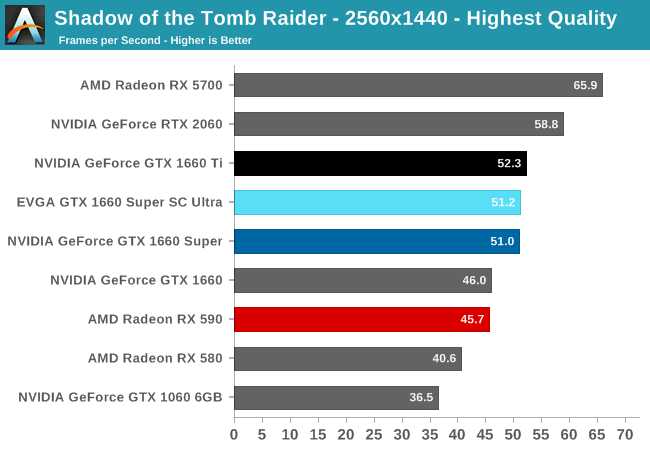
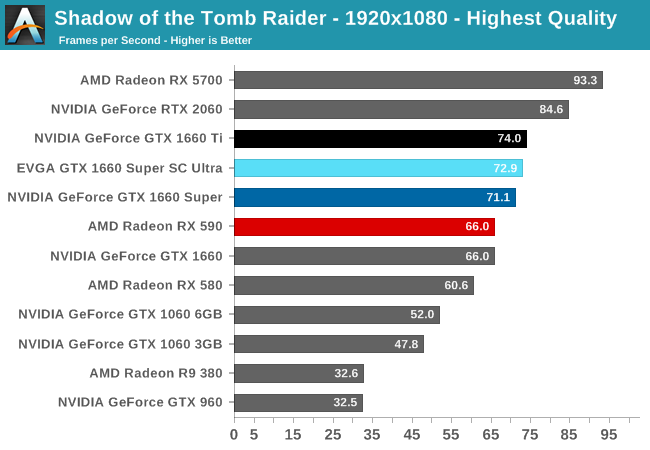
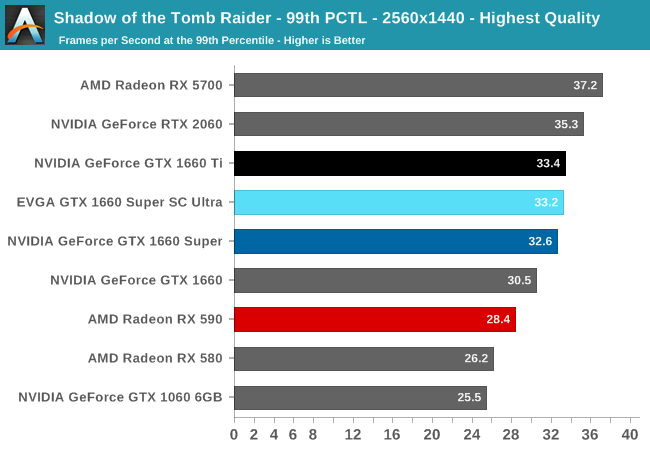
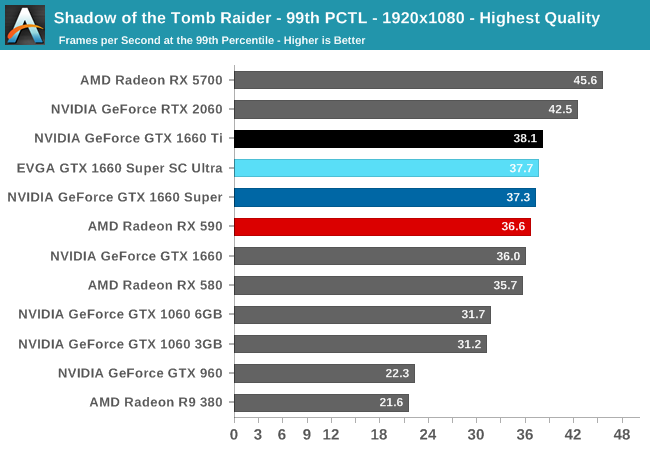
F1 2019
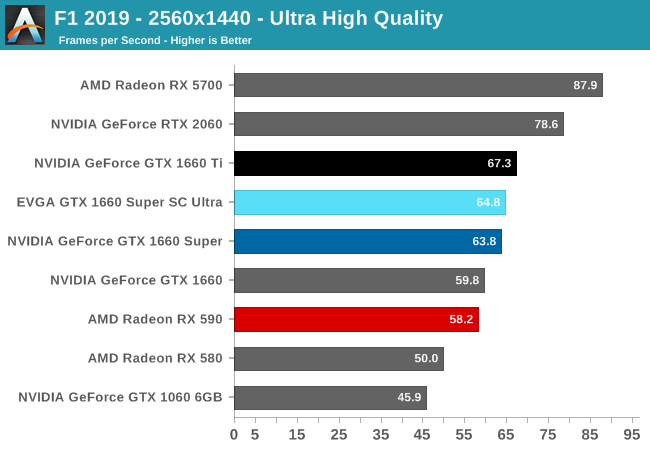
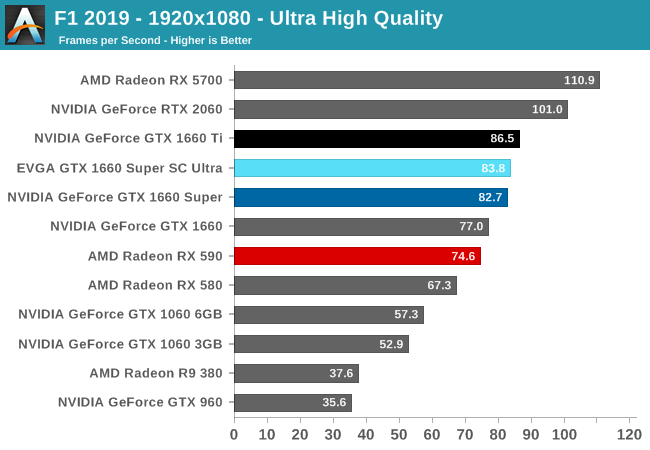
Assassin's Creed Odyssey
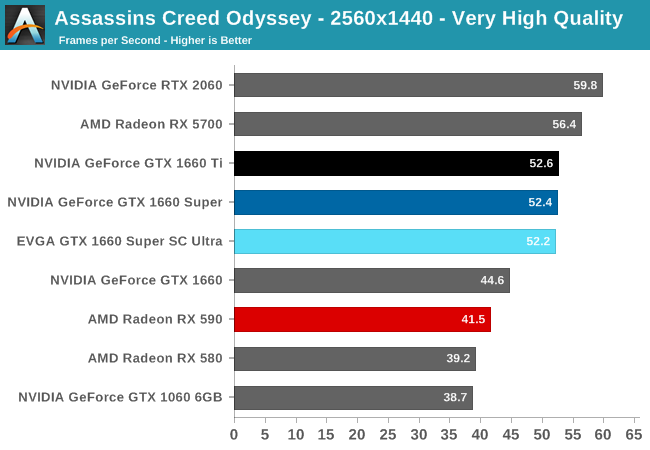
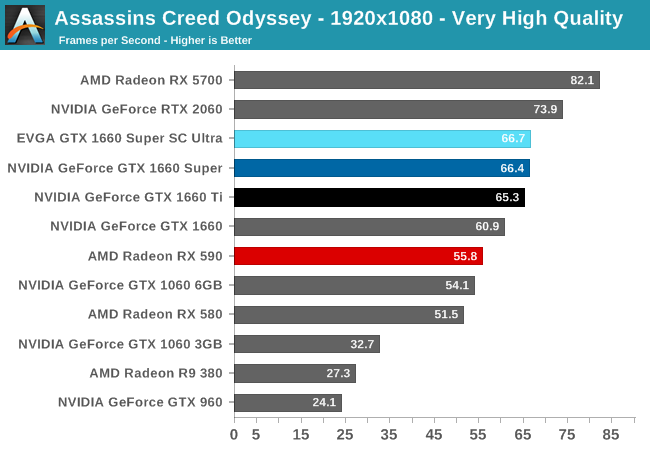
Metro Exodus
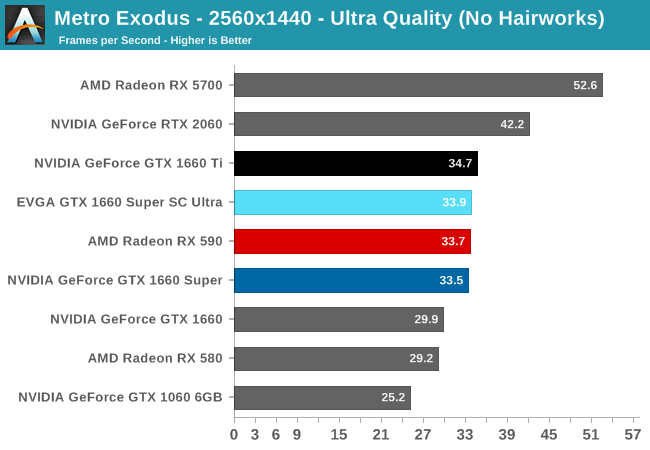
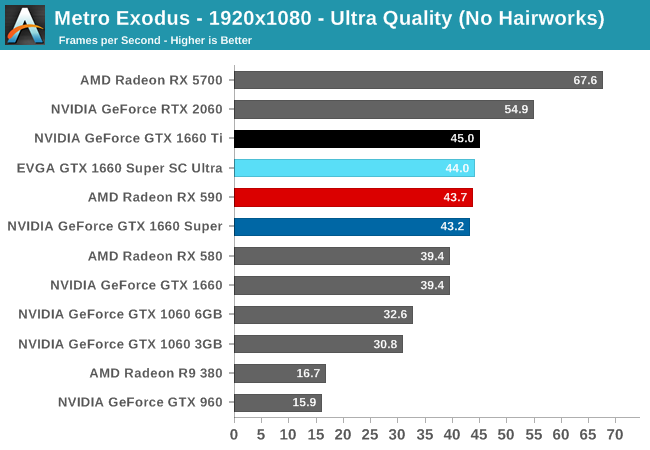
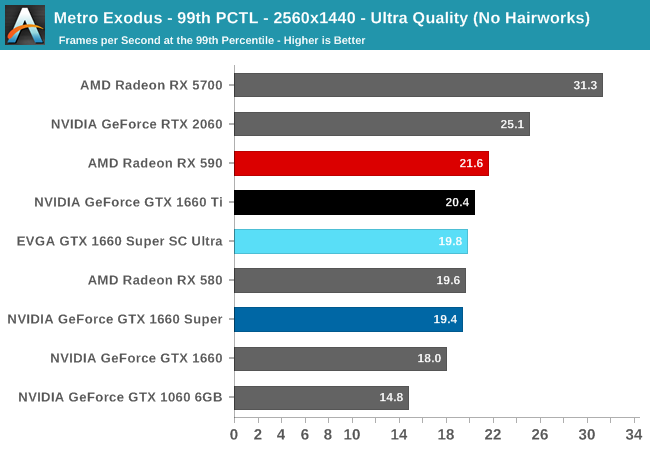
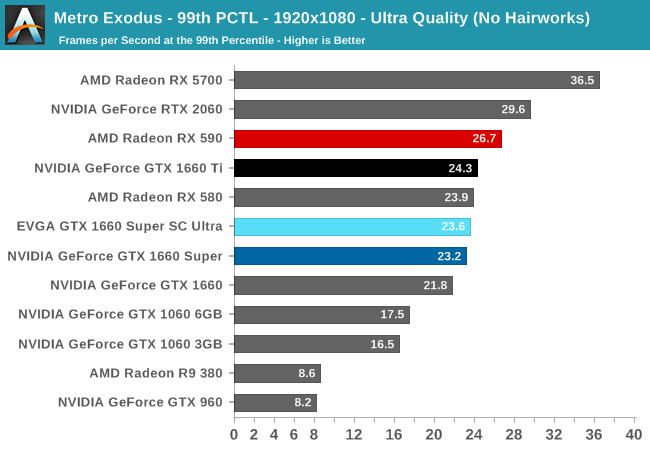
Strange Brigade
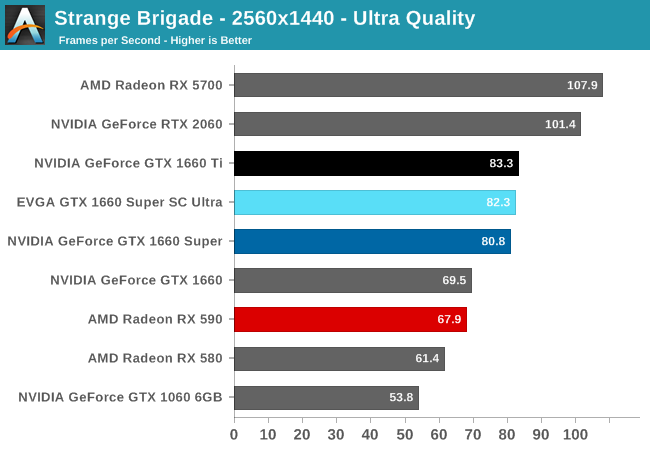
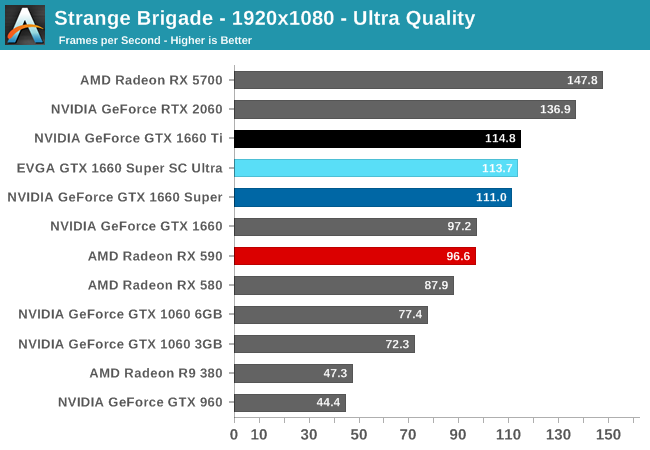
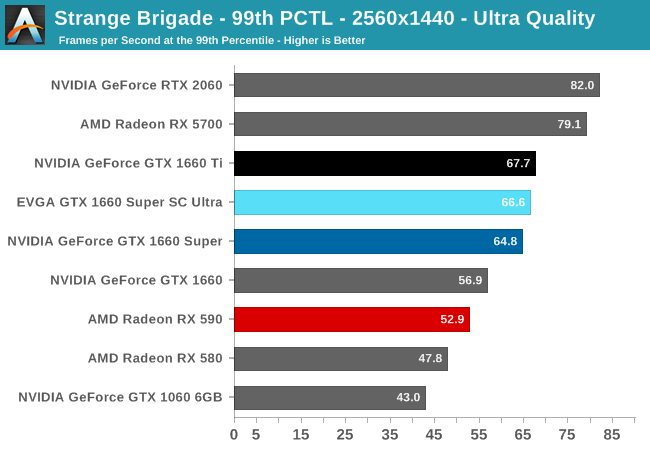
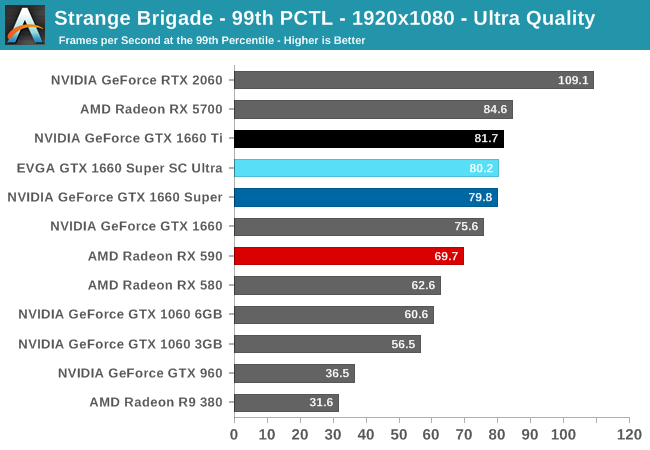
Total War: Three Kingdoms
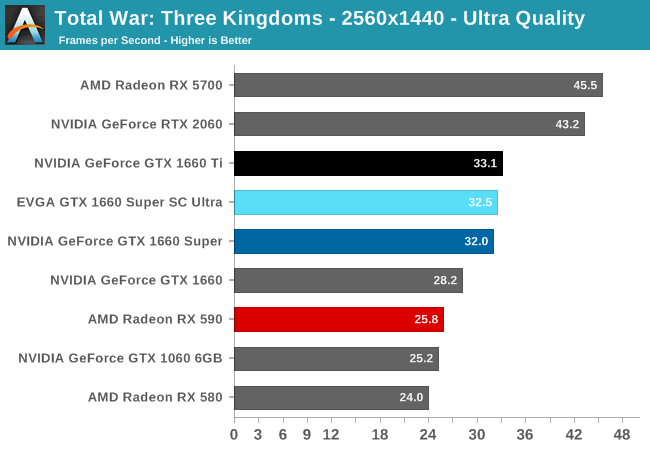
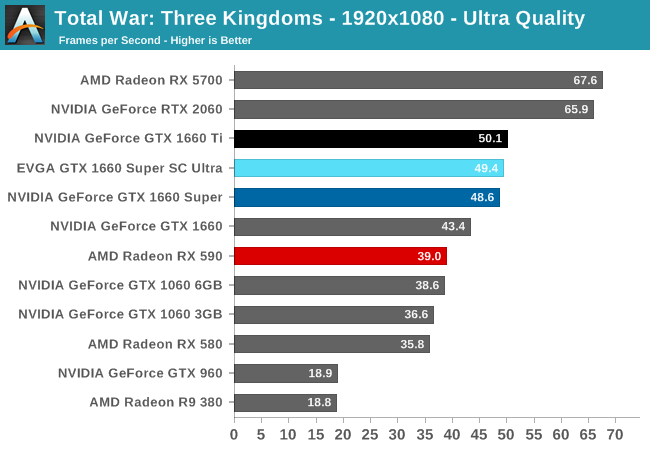
The Division 2
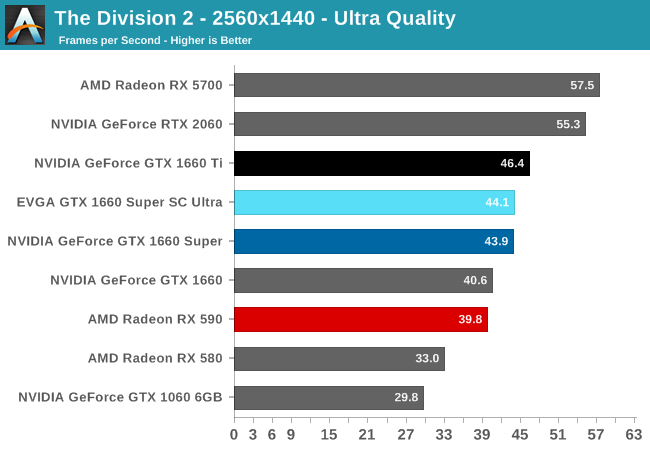
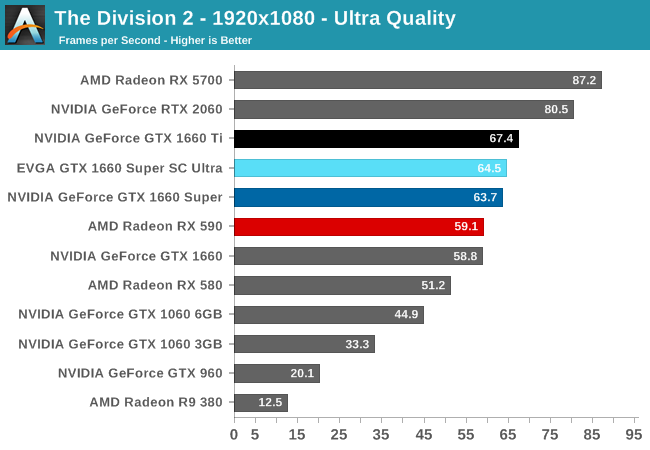
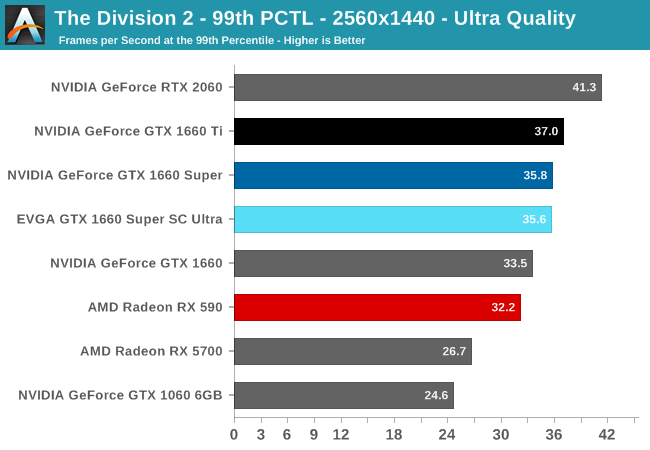
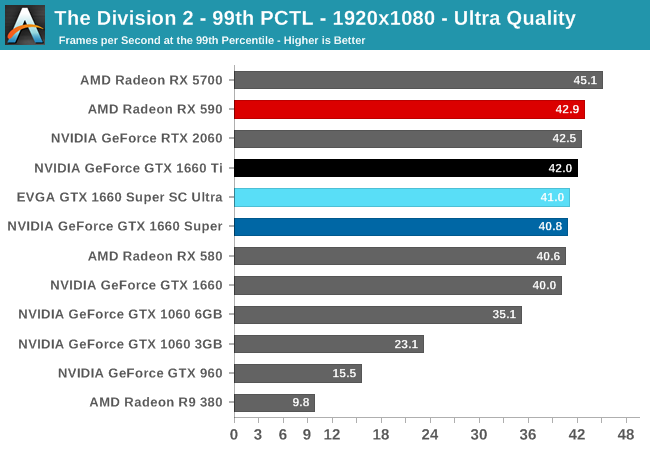
Grand Theft Auto V
Now a truly venerable title, GTA V is a veteran of past game suites that is still graphically demanding as they come. As an older DX11 title, it provides a glimpse into the graphically intensive games of yesteryear that don't incorporate the latest features. Originally released for consoles in 2013, the PC port came with a slew of graphical enhancements and options. Just as importantly, GTA V includes a rather intensive and informative built-in benchmark, somewhat uncommon in open-world games.
The settings are identical to its previous appearances, which are custom as GTA V does not have presets. To recap, a "Very High" quality is used, where all primary graphics settings turned up to their highest setting, except grass, which is at its own very high setting. Meanwhile 4x MSAA is enabled for direct views and reflections. This setting also involves turning on some of the advanced rendering features - the game's long shadows, high resolution shadows, and high definition flight streaming - but not increasing the view distance any further.
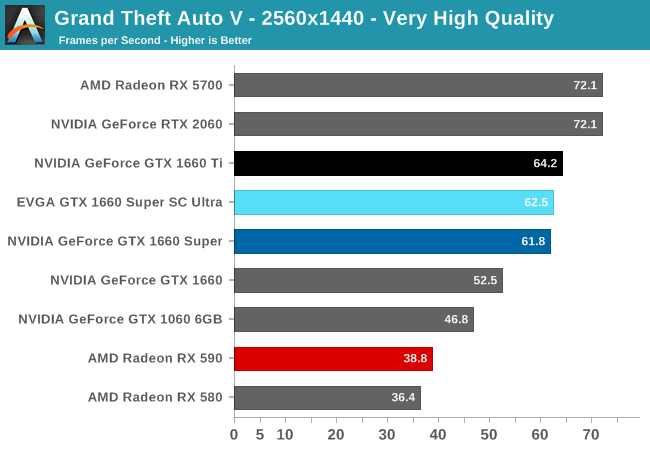
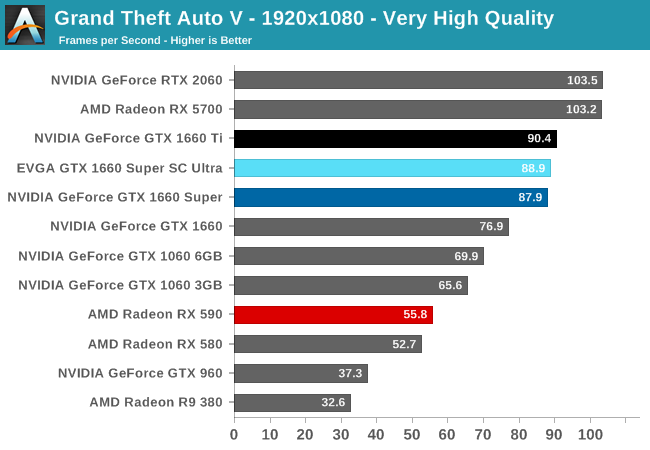
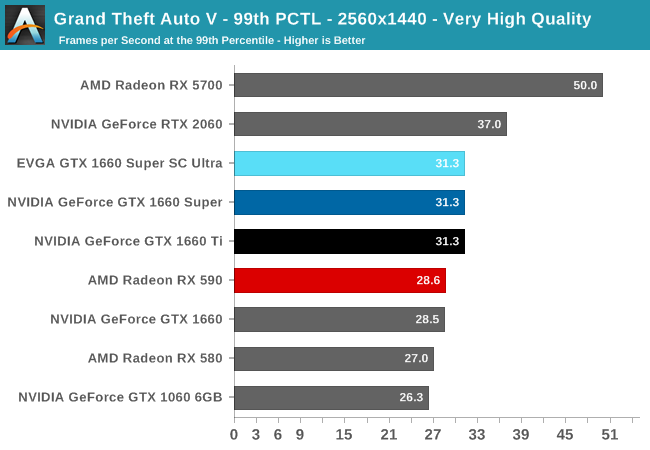
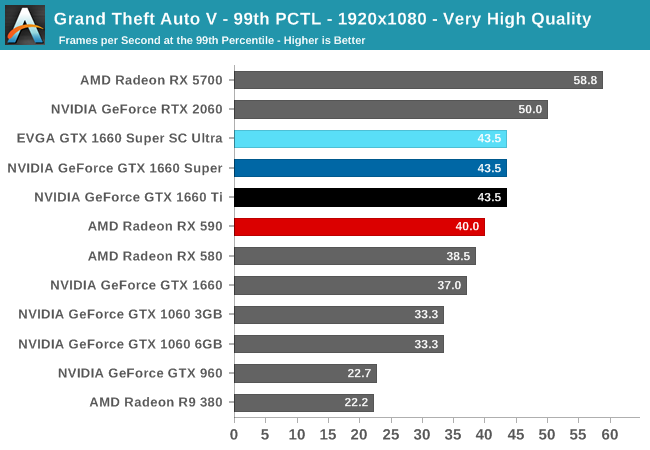
Forza Horizon 4
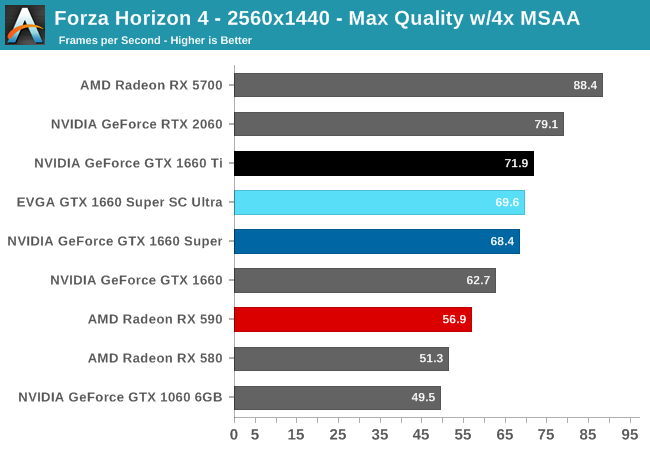
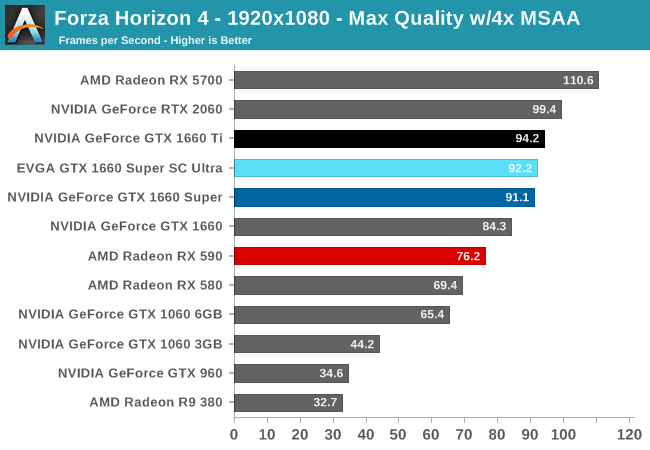
Compute
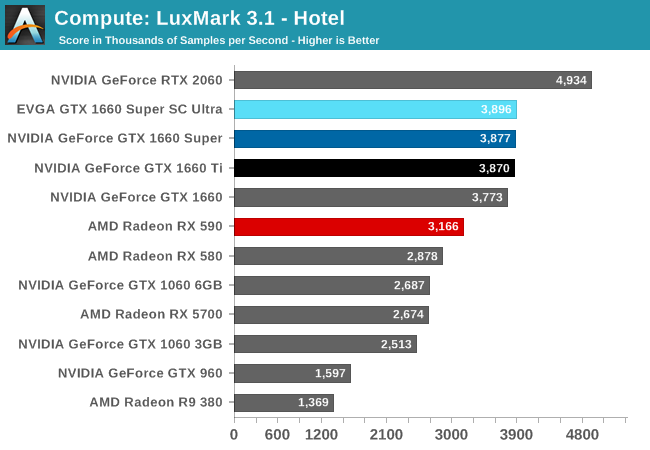
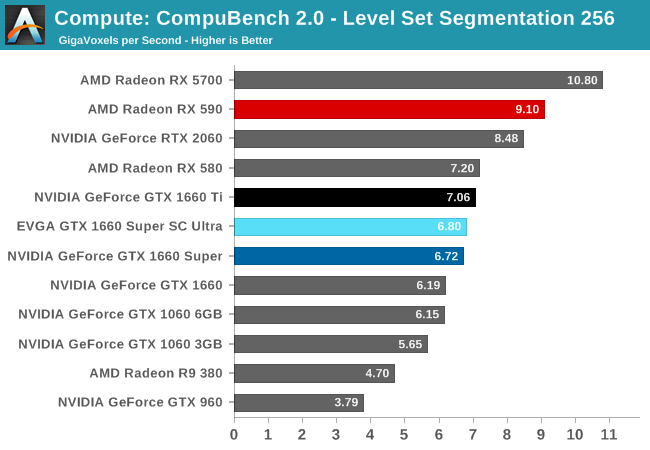
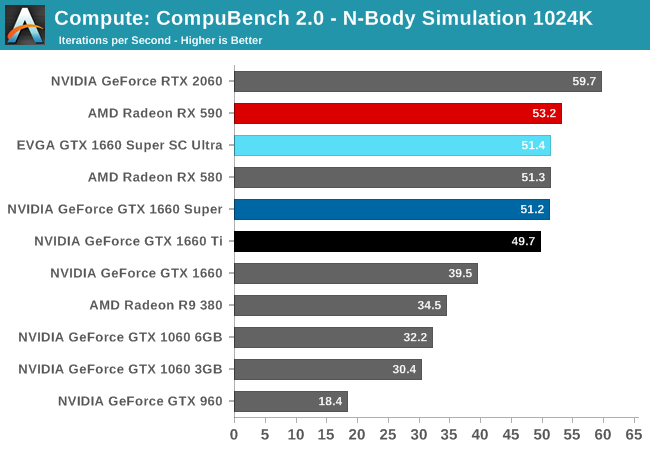
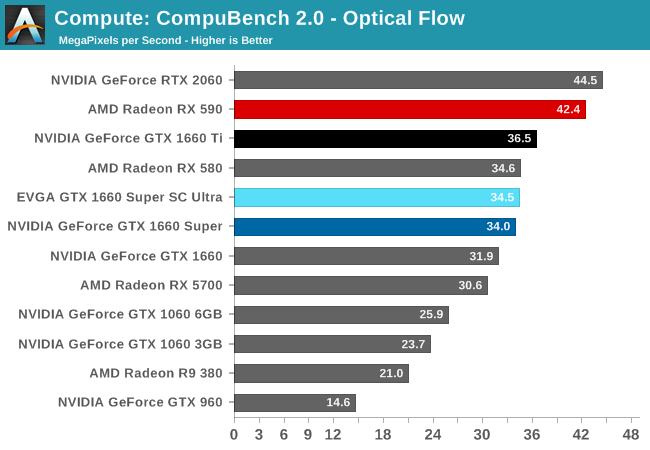
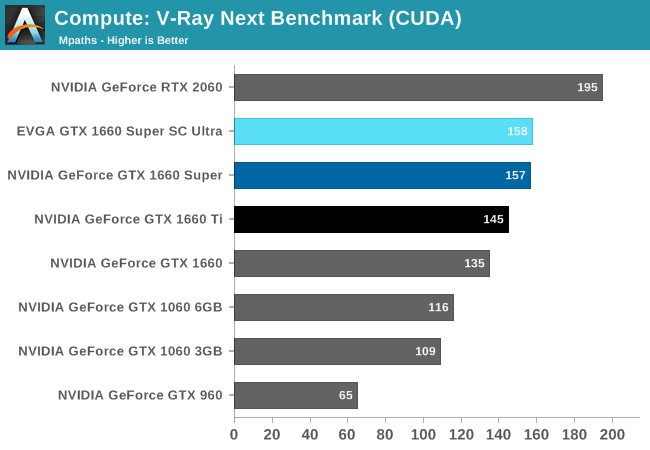
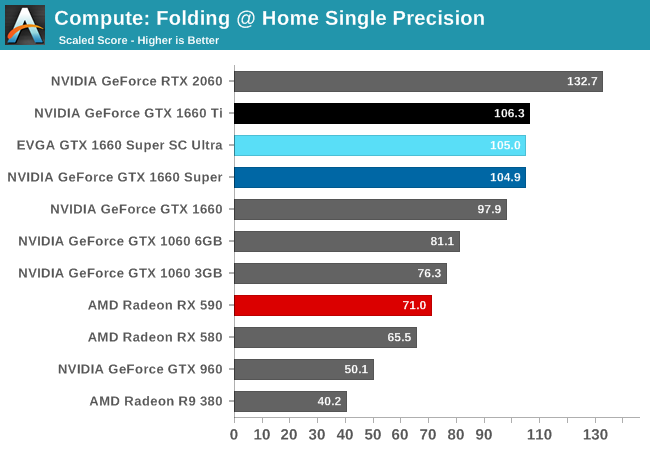
Synthetics
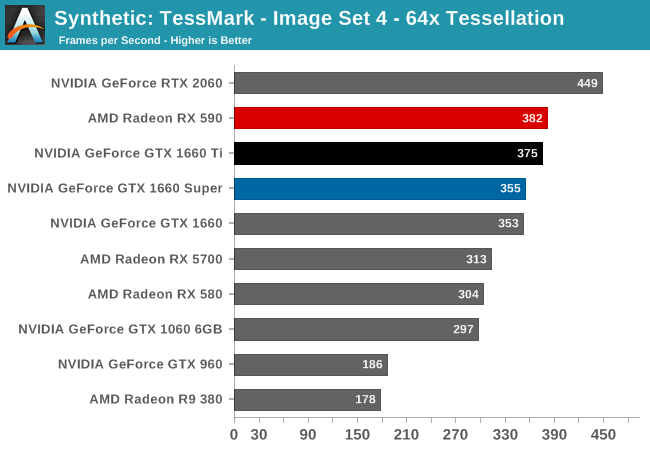
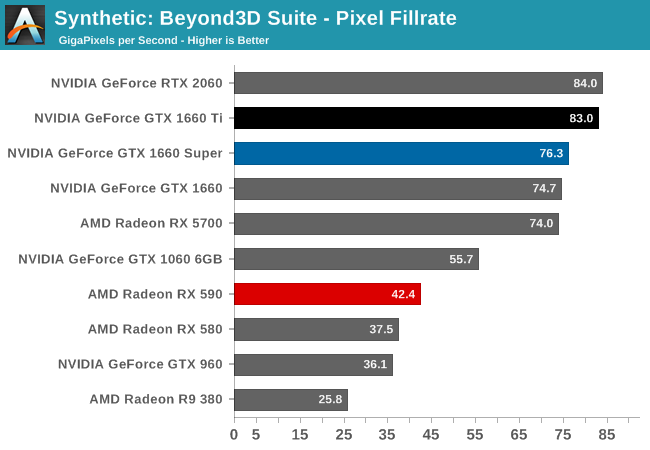
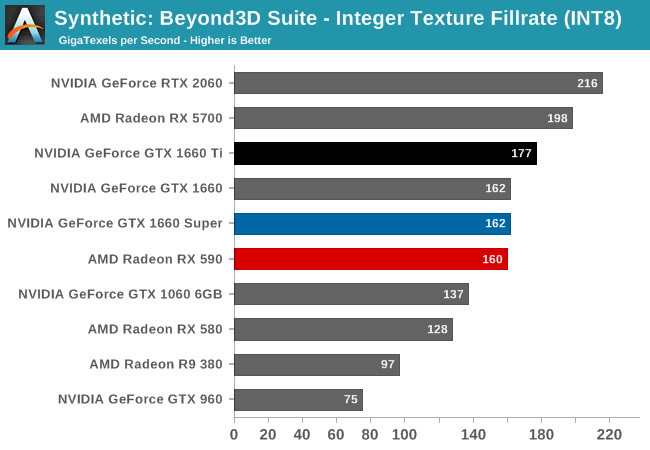
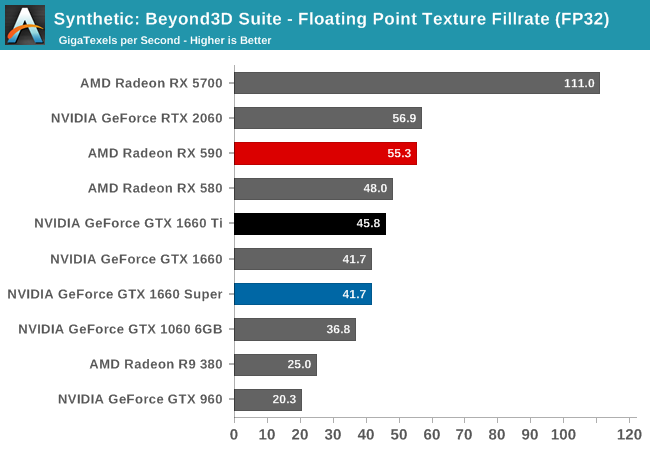
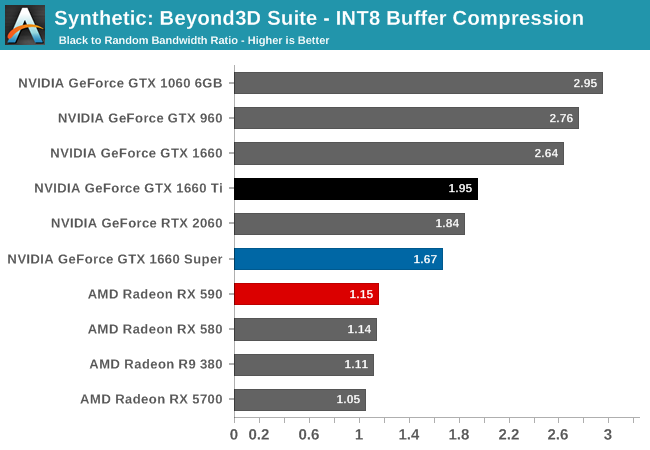
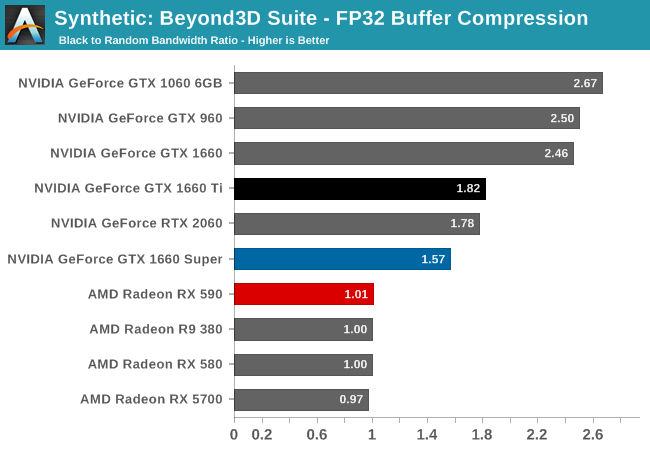
Power, Temperatures, & Noise
Last, but not least of course, is our look at power, temperatures, and noise levels. While a high performing card is good in its own right, an excellent card can deliver great performance while also keeping power consumption and the resulting noise levels in check.
| NVIDIA GeForce Video Card Voltages | ||
| Model | Boost | Idle |
| EVGA GTX 1660 Super Ultra SC | 1.05v | 0.618v |
| GeForce GTX 1660 | 1.043v | 0.656v |
| GeForce GTX 1660 Ti | 1.005v | 0.65v |
Using the same TU116 GPU as the GTX 1660 Ti and the GTX 1660 (vanilla0, the voltages are unsurprisingly similar. 1.05v is essentially a universal limit for NVIDIA Turing GPUs at stock, while the idle voltage of 0.618v is a bit lower than what we’ve seen on other TU116 cards thus far.
| GeForce Video Card Average Clockspeeds | |||||
| Game | GTX 1660 Super (Ref Clocks) |
EVGA GTX 1660 Super SC Ultra |
GTX 1660 Ti | GTX 1660 | |
| Max Boost Clock | 1935MHz | 1980MHz | 1950MHz | 1935MHz | |
| Boost Clock | 1785MHz | 1830MHz | 1680MHz | 1785MHz | |
| Shadow of the Tomb Raider | 1860MHz | 1905MHz | 1875MHz | 1875MHz | |
| F1 2019 | 1860MHz | 1905MHz | 1890MHz | 1875MHz | |
| Assassion's Creed: Odyssey | 1875MHz | 1920MHz | 1905MHz | 1890MHz | |
| Metro: Exodus | 1860MHz | 1905MHz | 1890MHz | 1875MHz | |
| Strange Brigade | 1860MHz | 1905MHz | 1890MHz | 1890MHz | |
| Total War: Three Kingdoms | 1860MHz | 1890MHz | 1890MHz | 1875MHz | |
| The Division 2 | 1845MHz | 1875MHz | 1875MHz | 1860MHz | |
| Grand Theft Auto V | 1875MHz | 1920MHz | 1905MHz | 1890MHz | |
| Forza Horizon 4 | 1875MHz | 1905MHz | 1905MHz | 1890MHz | |
The situation with clockspeeds is also very similar, though not entirely a carbon copy of the GTX 1660 (vanilla). Even with NVIDIA’s slightly higher TDP, our GTX 1660 Super card sees a very slight drop in clockspeeds, typically coming in one bin (15MHz, or under-1%) below the original card. In this case it’s a tradeoff we’re glad to take, since as we’ve just seen, the extra memory bandwidth on the GTX 1660 Super more than makes up for any clockspeed deficit, launching the Super card well ahead of its GDDR5-based predecessor.
In any case, the GTX 1660 Super once again comes in well ahead of NVIDIA’s official boost clock specifications. Even under The Division 2, average clockspeeds beat the spec by 60MHz, and in other games It’s more frequently 75 to 90MHz above.
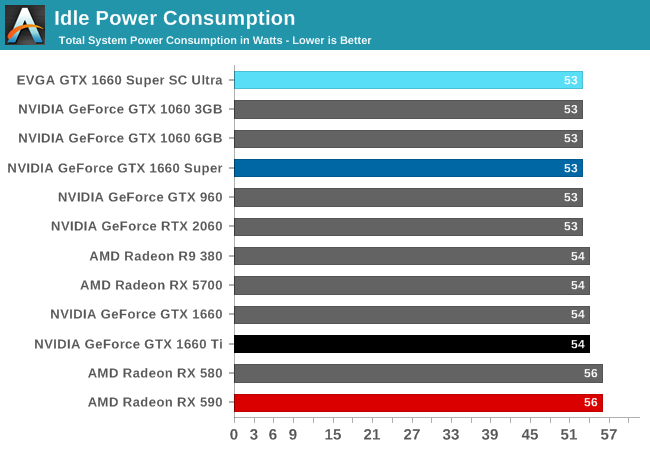
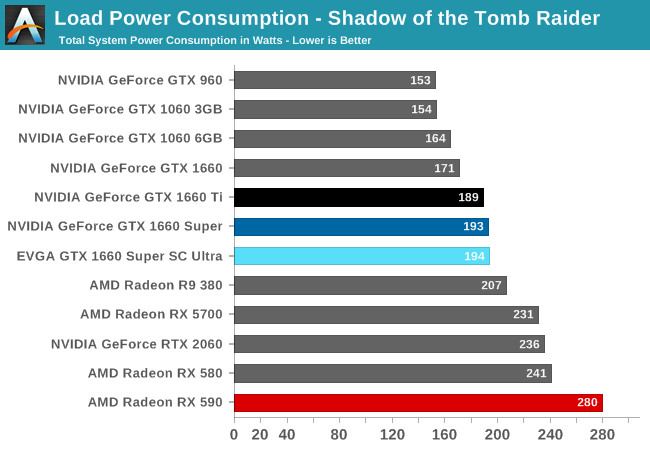
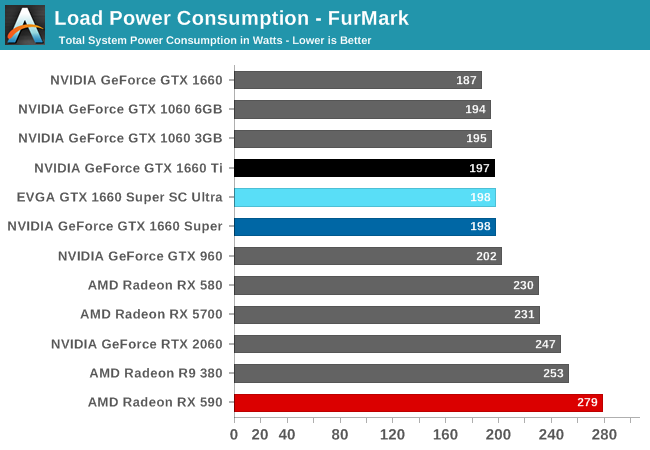
Shifting to power consumption, our results are in line with NVIDIA’s specifications, as well as what we’d expect for yet another TU116 card. With its 125W TGP, the GTX 1660 Super draws ever so slightly more power than either the GTX 1660 Ti or the GTX 1660, particularly in Tomb Raider where the CPU gets a bit more of a workout as well. But on the whole, it’s right in the ballpark with other 120W(ish) NVIDIA cards, with power consumption at the wall for the entire testbed not exceeding 200W.
For the midrange segment, the GTX 1660 Super (and the GTX 1660 Ti) are the cards to beat when it comes to power consumption and efficiency. Everything else at this power level performs much slower, or it’s faster while requiring more power. Though faster cards aren’t too far off, as the RX 5700 can attest to.
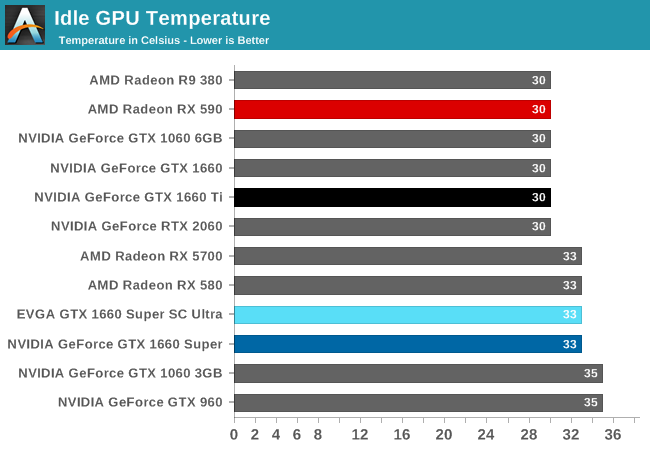
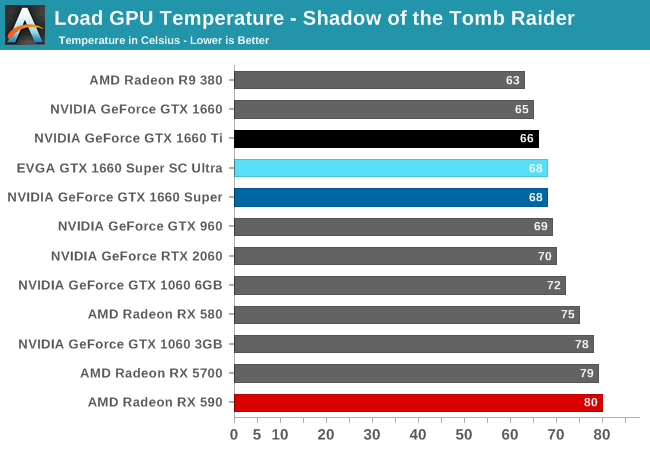
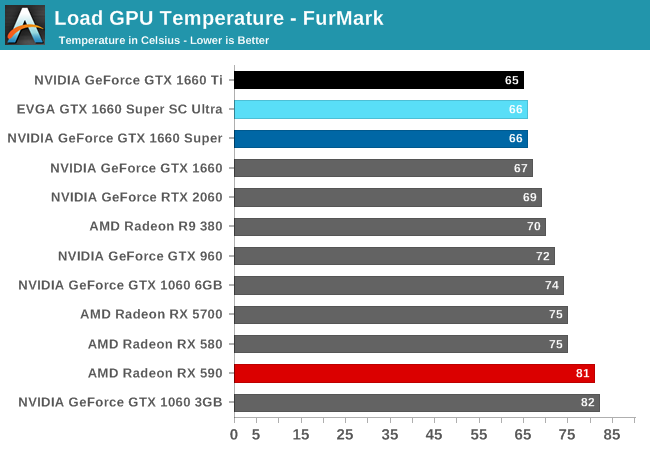
As for temperatures, EVGA has delivered one cool running card. Even at its full, factory overclocked speeds, the EVGA GTX 1660 Super SC Ultra never cracks 70C, and under FurMark’s pathological workload it’s the second-quietest card in these cards.
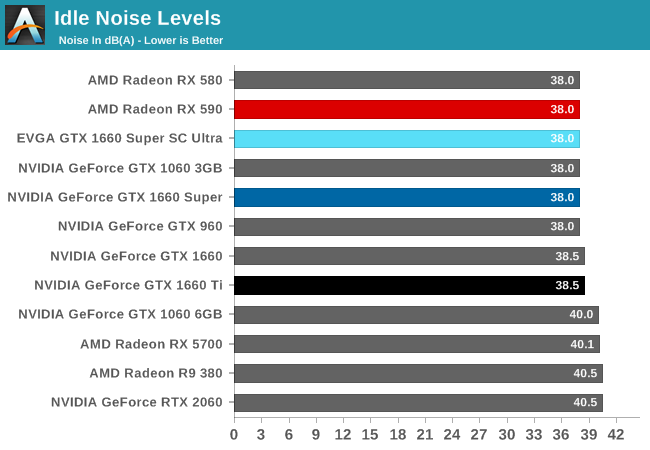
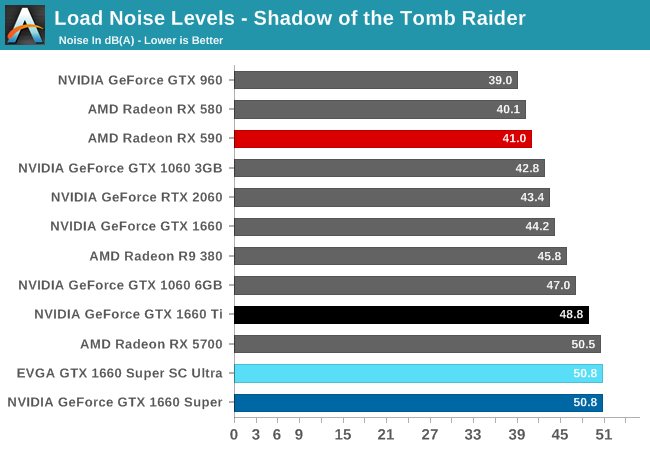
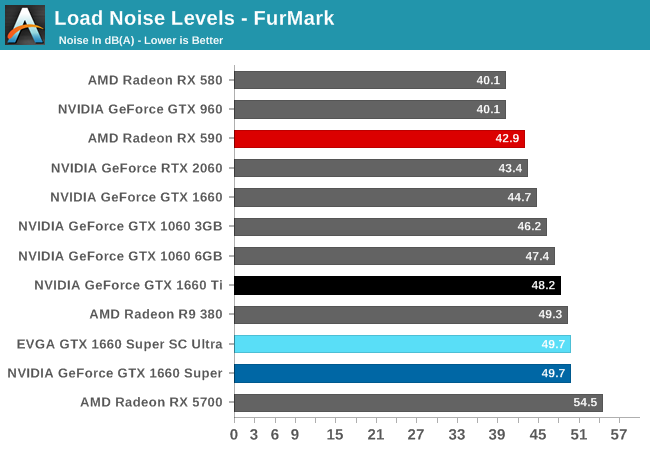
The tradeoff for those temperatures, however, is noise. The EVGA card that delivers chart-topping temperatures also delivers some of the worst noise results among this collection of cards.
The culprit here would seem to be EVGA’s decision to bias the card towards cooling performance rather than acoustics. Which given how far the card is from its 83C thermal throttle point, seems overdone. EVGA could easily back off on the fan speed a bit, let the temperatures drift up to the low 70s, and deliver essentially the same gaming performance (perhaps losing 1 bin in the process) while generating a lot less noise. We have a number of 120W open air cards in these cards, including the GTX 1660 3GB and GTX 960, both of which move just as much heat with much less noise, so it can be done. And, to be fair to EVGA here, their SC Ultra card is by no means a tornado, barely hitting 50 dB(A) in these intensive, open case tests, but the best cards strike a proper balance between noise and performance, maximizing the latter while minimizing the former.
Ultimately, I suspect part of the engineering challenge EVGA is dealing with here is that the SC Ultra cooler is their smallest GTX 1660 cooler. The triple-slot XC cards (represented here with the GTX 1660 Ti and GTX 1660) have just one fan and much bigger heatsinks to work with. Similarly, EVGA also sells longer dual-slot cards (also called XC) which get the benefit of a longer heatsink. The physics of more heatsink mass (and more/bigger fins) can’t be ignored, which is why smaller cards often need to run faster fans. Still, even if the SC Ultra cooler isn’t particularly big, I do think there’s room for a better fan balance here.
Tangentially, as I mentioned in the EVGA SC Ultra overview, this is actually our second card. The original was even hotter and louder; it reached 75C and 54.6 dB(A) under Tomb Raider in that test. Considering that these GTX 1660 Super cards are operating near or at their power limits and are TDP-capped by the VRMs and monitoring hardware – and thus, one card can’t draw significantly more power than another identical card – it points to a cooling problem with the card itself. EVGA has since taken the card back to figure out what’s going on, but I suspect what they’ll find is poor thermal transfer between the GPU and heatsink, perhaps due to a bad TIM application or a problem with the heatpipes. Ultimately it’s rare that we get dud video cards, but it does happen now and then.
Final Words
As a series of mid-generation kicker cards, NVIDIA’s Super cards have certainly lived up to the task. While none of these cards bring anything new to the table in terms of performance, they all have given NVIDIA’s price-to-performance ratio a swift kick upwards, and as the latest Super card, this is the case for the GeForce GTX 1660 Super as well. The net result is that while these cards don’t radically redefine the video card landscape, the GTX 1660 Super is at least going to recalibrate the mainstream market by bringing some of NVIDIA’s best gear down to lower prices, to the benefit of system builders and upgraders alike.
From a hardware perspective, you can either look at the new GeForce GTX 1660 Super as a GTX 1660 with a much-needed upgrade to GDDR6 memory, or a GTX 1660 Ti with a couple of SMs fused off. Both would be accurate statements, and both set the correct expectations in terms of performance. The GTX 1660 Super is a very fast card for its market segment, and because it’s so similar to the GTX 1660 Ti in configuration, it’s also similar to it in performance, only trailing NVIDIA’s fastest 1660 card by a few percent.
Which perhaps isn’t remarkable in and of itself, but what the GTX 1660 Super doesn’t bring to the table in terms of new hardware, it brings to the table in terms of pricing. NVIDIA is launching this card at $229, which is $50 below where the GTX 1660 Ti launched back in February – and indeed, what it still sells for today. Meanwhile at the other end of the spectrum, the new Super card delivers 12% better performance than NVIDIA’s $219 vanilla GTX 1660, all for a decabuck ($10) more.
As a result, at current prices the GTX 1660 Super all but makes the other GTX 1660 cards redundant; the Ti isn’t fast enough to justify the price, and the vanilla GTX 1660 isn’t cheap enough to justify the performance hit. Put another way, why have a GTX 1660 Ti at GTX 1660 Ti prices, when you could have it without the TI price premium? In this respect it’s a lot like the launch of the RTX 2070 Super over the summer; it’s not quite as fast as the card above it (RTX 2080), but for a few percent drop in performance, it’s a whole lot cheaper. Ultimately, while NVIDIA’s current 10 card product stack is a bit unwieldy, once you reach the GTX 1660 series, there’s really only one card to consider, and that’s the GTX 1660 Super.
None of this, I think, should be too surprising given what NVIDIA is announcing today in terms of specifications and pricing. They clearly intended to deliver a lower-priced GTX 1660 Ti-like card, and this is exactly what’s happened. The lingering question then is not what they’ve done, but why they’ve done it. And for the answer to that, I suspect we’re going to have to wait to see what happens with AMD’s Radeon RX 5500 series cards, which are expected to launch into retail sometime this quarter. It’s been AMD actions that have spurred NVIDIA’s other price/performance realignments this year, and it’s likely the same case here.
| Performance Summary (1080p) | |||||
| Relative Performance | Relative Price |
Relative Perf-Per-Dollar |
|||
| GTX 1660S vs RTX 2060 | -17% | -30% | +24% | ||
| GTX 1660S vs GTX 1660 Ti | -3% | -18% | +18% | ||
| GTX 1660S vs GTX 1660 | +10% | +5% | +5% | ||
| GTX 1660S vs GTX 1060 6GB | +37% | -8% | +49% | ||
| GTX 1660S vs GTX 960 | +158% | +15% | +124% | ||
Shifting gears, let’s talk about EVGA’s GeForce GTX 1660 Super SC Ultra. The dual-fan, dual-slot card is fairly typical of what to expect for GTX 1660 Super cards in terms of design, as dual-fan coolers have long proven themselves (and their popularity) in this market segment. And while EVGA’s card delivers on all of the performance one would expect from GTX 1660 Super – and then some thanks to a mild factory overclock – I’m ultimately left with mixed feelings about it. The hardware is solid, but the acoustic results are mediocre; the card is fairly loud for a piece of hardware that only has to dissipate 125W of heat. Not that a lot of our readers care about noise versus price or performance, but for those who do, it’s something to chew on. Personally, I’d like to see EVGA balance their fan curve a bit more so that it’s not unnecessarily aggressive, but barring that, the matter is easy enough to address at the user level with EVGA’s always-excellent PrecisionX overclocking software.
Finally, from a deep technical perspective, the launch of the GTX 1660 Super has given us an extremely interesting look at the performance differences between memory generations, and this is something we very rarely get. While GPU memory controllers typically support a couple of different types of memory, within midrange or high-end cards we virtually never see memory types mixed in this fashion; cards with older memory types are almost universally sold as lower-end parts with further neutered GPU configurations to match. So the GTX 1660 Super lets us see first-hand the performance impact of GDDR5 versus GDDR6 with fully identical GPUs.
The results then, are surprising in a sense. While I did not expect performance gains to be anywhere near the 75% increase in memory bandwidth – the vanilla GTX 1660 was never entirely memory bandwidth-bound – I am surprised that the performance gains from the switch to GDDR6 are so consistent. To be sure, the GDDR6-equipped GTX 1660 Super is anywhere between 7% and 17% faster than the GDDR5-equipped GTX 1660, but that’s a rather narrow range all things considered. Even in the worst case scenario, just adding more memory bandwidth pushed performance up by at least 7%, and yet even in the best case scenario, it added no more than 17%. There are no purely GPU-limited gaming scenarios where the extra bandwidth did nothing, and there are no memory-bound scenarios where more bandwidth led to vast performance improvements.
Some of this, I suspect, is simply because GDDR6 is such a large jump that it’s outpacing what GPUs currently need. Which is an odd thing to say for a class of products that are virtually defined by their ever-shrinking amount of bandwidth-per-FLOP, but GDDR6 will be with us over multiple GPU generations, just like GDDR5 was prior to that. So GPUs aren’t going to see the same kind of single-generation 75% jump in bandwidth again, and GPU vendors can never let their foot off of the pedal when it comes to improving GPU memory efficiency.
It’s this last point, perhaps, that is keeping the GDDR6 performance gains as consistent as they are. Despite pushing 5+ TFLOPs, the vanilla GTX 1660 isn’t incredibly burdened by GDDR5. It’s held back for sure – losing upwards of 15% of its performance just by missing out on so much memory bandwidth – but it’s not handicapped. NVIDIA has been able to get an immense amount of performance out of GDDR5 cards despite the very limited bandwidth increases over the years there, and this Super comparison helps to underscore that.
Not that the company will mind more video card bandwidth. GDDR6 may be around for years to come, but first we have 16Gbps GDDR6 on the near-term roadmaps. And by the time NVIDIA is ready with a new generation of video cards, even a small bump in memory bandwidth will go a long way towards feeding a ever wider and more powerful GPUs.

